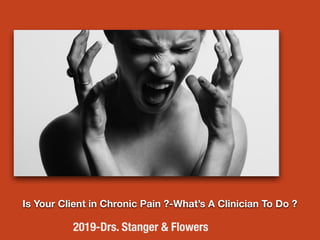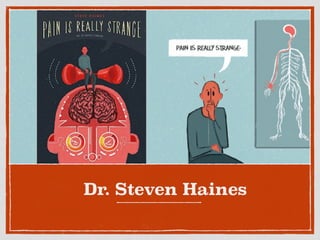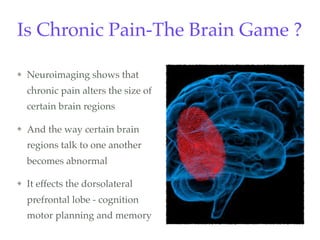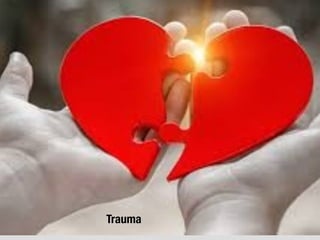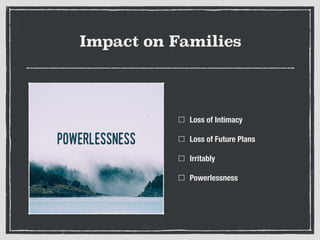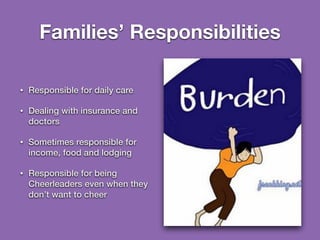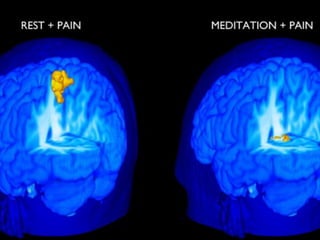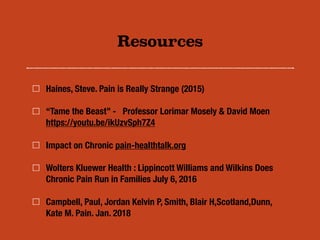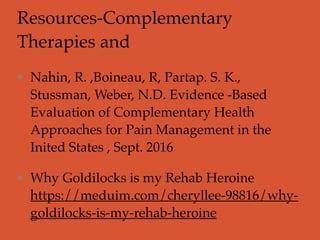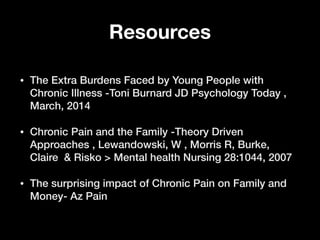Is your client in chronic pain?
- 1. Is Your Client in Chronic Pain ?-What’s A Clinician To Do ? 2019-Drs. Stanger & Flowers
- 2. Louise Stanger Ed.D, LCSW, CDWF, CIP Founder All About Interventions Author-The Definitive Guide to Addiction Intervention, 2018 & Falling Up- A Memoir 2016 Speaker-Trainer-Consultant Family Programs www.allaboutinterventions.com 619-507-1699 Clinician-Interventionist
- 3. James S. Flowers PhD, LPC-S Founder and CEO, Kemah Palms Recovery Founder and CEO, Cypress Lakes Lodge Founder and CEO, J Flowers Health Institute Anthony Fry Director of Business Development (713) 515-3467 Anthony.fry@kemahpalms.com Kyle Infante Chief Marketing Officer (214) 226 - 7422 Kyle.infante@cypresslakeslodge.com Joshua Walker Vice President, Relationship Management (720) 338-0658 Joshua@jflowershealth.com
- 4. Objectives Discuss Chronic Pain and Chronic Pain Syndrome Demonstrate the Interplay of Mental Health Problems with Chronic Pain Reveal how our Brain Tricks us with Chronic Pain Present Evidence Based strategies that are effective with Chronic Pain
- 5. Objectives Identify what is Unique about Chronic Pain Families Identify How to Work with Clients and their families Introduce Family mapping as a Way Into Story Present Strategies for Clients & Families that have SA, MH, and CP
- 7. 100 Million- One in Ten Americans - 1.5 Billion Globally
- 8. Chronic Pain Chronic Pain affects over 133 million Americans or over 1/3 of our population Annual cost of $635 million More common among women then men More common among older persons
- 9. Chronic Pain Arthritis Fibromyalgia Crohn’s Disease Concussions Spine Accidents Pelvic Pain Hips, Knees, Shoulders, Spines
- 10. #1 Cause of Long Term Disability Concussions Facial pain Neck Pain Accidents -Driving, Texting Exercising, Weekend Warrior Tasks Hips, Knees , Shoulders
- 11. More Types of Chronic Pain • 28% Low Back Pain • 15% Migrane or Headache • 15 % Neck Pain • 4 % Facial Pain • #1 Cause of long term disability
- 14. But what exactly is Chronic Pain? Pain that lasting longer then 12 weeks For the most part pain has been treated in terms of body parts
- 16. All Pain is Real>>>>
- 19. With chronic pain the neurotransmitters neurotransmitters Prevent certain regions from turning off when they should Result the brain is overly sensitive to pain and stimulates a feed-forward cycle that reinforces the chronic pain state
- 20. Neurotags and Pain Descartes and our Brain Attachment Theory < Pain and The Brain
- 21. Is Chronic Pain-The Brain Game ? Neuroimaging shows that chronic pain alters the size of certain brain regions And the way certain brain regions talk to one another becomes abnormal It effects the dorsolateral prefrontal lobe - cognition motor planning and memory
- 24. Effects of Chronic Pain • 77% report feeling depressed • 51% feel they have little or no control over their pain • 20% report sleep is disrupted due to chronic pain
- 25. Young People and Chronic Pain • Treated as if Health issues can’t possibly be chronic • Are told they are too young to have Chronic Pain • Worry they will never find a romantic partner • Worry they will never finish school • Sit by and watch as others their age participate in activities that they cannot do.
- 26. Work and Chronic Pain • Cost estimated 62.1 billion Jama • Employers Believe: • They are unreliable • They are less productive • They use pain as a excuse
- 27. Chronic Pain and Addiction Pain Patient becomes out of control with medications Becomes drug seeking - quality of life decreases Medication will continue or increase despite side effects . Hyperalgesia
- 28. Pain Holds Us Hostage
- 29. Pain- Substance Misuse- Brain -Attachment
- 30. Over Lapping Features of Chronic Pain & Addiction Trauma Loss of Control Loss of Mastery Loss of Sense of Self Cognitive Error Overinterpretation Catastrophe Personalization Daily Life Alters Trauma Loss of Mastery Loss of Control Loss of Sense of Self Loss of Self-efficacy Cognitive Error Denial Daily Life Alters
- 31. Trauma
- 32. Pain becomes the organizing force that Families Coalesce Around
- 33. Impact of Chronic Pain On Identified Loved One Pain Does not Show Doubt about Pain Fluctuating Activity Levels Unpredictable Mood Swings Isolation Loss of Friends, relationships (sexual etc) and productivity
- 34. It is difficult to Explain Chronic Pain to Families, Friends etc They cannot Hear. Pain does not have a weight or height or length 75% of all marriages end in the US in divorce when one partner experiences a chronic illness
- 35. Impact of Chronic Pain on Families Increased responsibility for maintaining home and income Increased responsibility for transporting to Doctors etc Inability to Truly understand pain
- 36. Frazzled- Bewildered- ConFused- Angry- Mad- Sad
- 37. Impact on Families Loss of Intimacy Loss of Future Plans Irritably Powerlessness
- 38. Chronic Pain Families Armed with Medical knowledge Intimidated by Medical Feel, Guilt, Shame,Confusion Dr. Knows Best
- 39. Families are Fractured from Anxiety Depression, Addiction and Chronic Pain
- 40. Families’ Responsibilities • Responsible for daily care • Dealing with insurance and doctors • Sometimes responsible for income, food and lodging • Responsible for being Cheerleaders even when they don’t want to cheer
- 41. Family Mapping A Way Into
- 42. The Power of Language • What you say about Pain Reflects on how you feel • Affects how you feel • SELF-FULLING PROPHECIES • CATASTROPHIZING • PROJECTING • TEACHING ONE TO BE THEIR OWN CEO-
- 43. Pain Requires an Audience • Pain is never good without an audience- excused from chores, work etc • People don’t hurt as much if they have something better to do • Work and activities to set goals, not to pain tolerance • Empowerment/Goaling Process • Exercise
- 44. Families Learn • Their History • Their Ways of Communicating • To take Care of Themselves • To Discover Curiosity • To Discover Joy • To try Out New Ways of Relating
- 45. “YOU CANNOT HEAL WHEN YOU ARE STRESSED ALL THE TIME. “
- 47. QIGONG Qi-“Subtle breath”,Gong-“Vital energy Slow movements warm tendons, muscles and ligaments & Muscles, Promote circulation of body fluids Effective for chronic illness , emotional frustration, stress and spiritual crisis etc (NQA)
- 48. YOGA Mind-body practice Low Back Pain Arthritis 2011studies military
- 49. Music Fibromyalgia, arthritis , joint pain , nerve disorder
- 50. Accupuncture Chronic Back pain, (2010-2012) Joint pain, (osteooarthritis) Knee and Hip pain Headaches/Migraine Fibermyalgia Detoxification
- 51. Spinal Manipulation PT, Naturopaths, Osteopathic Physicians, Chiropractors AHRQ -Low Back Pain withers as effective as medications Headaches Neck Pain
- 52. Aquatic Therapy
- 54. Food Reduce Pain and Inflammation
- 56. Thom
- 57. Maddi 10 operations - 6 treatment centers
- 58. Meet Sally
- 59. Meet Renee
- 60. Meet George
- 61. 11 Tips to help a Loved one Ask Questions Attend-Learn about Condition - Get Consent form from Dr Understand MRIs are over given Learn about Pain management Strategies Try the Pain Management Strategies they can be helpful for everyone
- 62. 11 tips to Help Clients help Loved Ones Collaborate in Goal setting Boundaries Share Activities Communicate-Be Direct, honest Encourage Find Time to Laugh
- 65. Resources Haines, Steve. Pain is Really Strange (2015) “Tame the Beast” - Professor Lorimar Mosely & David Moen https://youtu.be/ikUzvSph7Z4 Impact on Chronic pain-healthtalk.org Wolters Kluewer Health : Lippincott Williams and Wilkins Does Chronic Pain Run in Families July 6, 2016 Campbell, Paul, Jordan Kelvin P, Smith, Blair H,Scotland,Dunn, Kate M. Pain. Jan. 2018
- 66. Resources Stanger articles https://www.allaboutinterventions.com/pain- management-and-opioid-addiction/http:// www.huffingtonpost.com/entry/ Stanger, Porter, Flowers Huffington Post-Trauma and Addiction http://www.huffingtonpost.com/entry/trauma- addiction-whats-the-difference_us_58d14912e4b0e0d348b347f3 Flowers Articles,https://www.thriveglobal.com/authors/3611- james-s-flowers-phd-lpc-s-and-angela-harris-msw-candidate Stanger,https://www.allaboutinterventions.com/current-news/
- 67. Resources-Pain and The Brain R, L. Nahim, Estimates of pain prevalence and severity in adults, 2012, “j Pain, vol.16, no 8 pp789-80 A. May, “Structural Brain Imaging. A Window into Chronic Pain", The Neuroscientist,vol17,No 2,pp.2019-220, 2011 Napadow& R.E. Harris ,”what has functional connectivity and chemical neuroimaging in fibromyalgia taught us about the mechanisms and management of centralized pain ? Arthritis Research and Therapy .vol 16 Ingemanson, Morgan PHD , “Chronic Pain Lives in the Brin, April 17, 2017 Vox Brain Map http://evoxbrainmap.com/chronic-pain-lives- brain/
- 68. Resources-Complementary Therapies and Nahin, R. ,Boineau, R, Partap. S. K., Stussman, Weber, N.D. Evidence -Based Evaluation of Complementary Health Approaches for Pain Management in the Inited States , Sept. 2016 Why Goldilocks is my Rehab Heroine https://meduim.com/cheryllee-98816/why- goldilocks-is-my-rehab-heroine
- 69. Resources Prevalence of Chronic pain Among Adults CDC Sept. 14, 2018 https://www.cdc.gov/mmwr/volumes/67/wr/ mm6736a2.htm 10 Tips To help A Loved One in Pain-Survive and Thrive Pohl, Mel. A Day Without Pain. Central Recovery Press Pohl, Mel. Pain Recovery. How to Find Balance, Reduce Suffering from Chronic Pain. 2008 .Central Recovery Press
- 70. Resources • The Extra Burdens Faced by Young People with Chronic Illness -Toni Burnard JD Psychology Today , March, 2014 • Chronic Pain and the Family -Theory Driven Approaches , Lewandowski, W , Morris R, Burke, Claire & Risko > Mental health Nursing 28:1044, 2007 • The surprising impact of Chronic Pain on Family and Money- Az Pain
- 71. Resources-Family Mapping Brown, Brene- Rising Strong . Speiegel & Grau International 2015 NYC NY Brown, Brene, DaringGreatly. Gothom Books 2012 Lawrence Lightfoot,Sarah & Hoffman Jessica .TheArt and Science of Portraiture. Joey Bass. 1997 LawrenceLightfoot, S. Respect , 1998. Press Books, Mass. Lawrence, Lightfoot,S. I’ve Known Rivers , Penguin Publishing. Ny 1995 Lawrence, Lightfoot, S Growing Each Other Up, University of Chicago Press. 2016
- 72. Resources About The Opioid Epidemic http://www.nbcnews.com/nightly-news/video/louisville-kentucky- sees-spike-in-heroin-overdoses-876423747884 Achenbach, Joel.The Washington Post, Dec.23, 2016. An opioid epidemic is what happens when only treated with pills. Gebelhoff, R. The opioid epidemic can turn into a pandemic if we are not careful. The Washington Post .Feb. 9, 2017 https:// www.washingtonpost.com/news/in-theory/wp/2017/02/09/the-opioid- epidemic-could-turn-into-a-pandemic-if-were-not-careful/? utm_term=.d7f5c8218e3c

